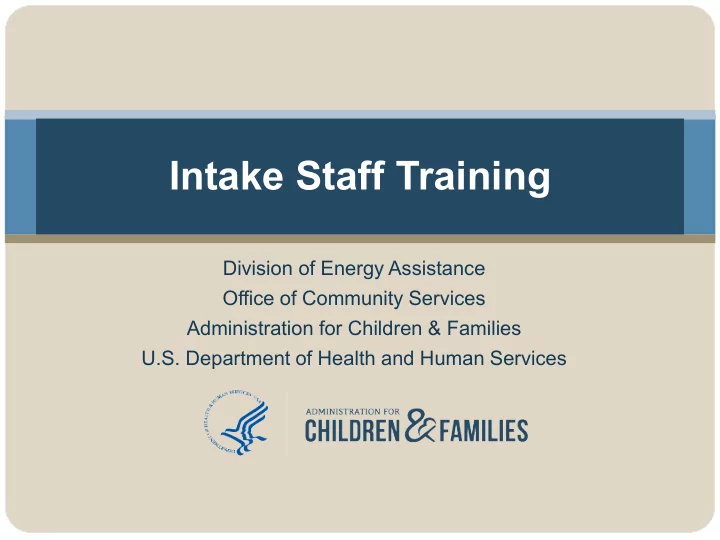

Intake Staff Training Division of Energy Assistance Office of Community Services Administration for Children & Families U.S. Department of Health and Human Services
Agenda Training Initial Contact Crises Discussing Benefits Wrap-Up 2
Training This section introduces best practices for training subgrantees and staff. 3
Intake Staff Training LIHEAP Funds are available for people who need assistance with energy costs. Individual programs must determine eligibility and the amounts. What questions do you have? 4
Intake Staff Training (continued) What went well? What did not go well? What should have been done differently? What have you done in your training that has worked well? 5
Initial Contact This section reviews the rules and practices surrounding initial contact. 6
Initial Contact Is that the correct way to handle the call? Why or why not? How do you handle callers when there is no money available? Do you train your subgrantees on phone etiquette? 7
Crises This section discusses how different groups define crises. 8
Crisis Defined Grantees vary in how they define an energy crisis and establish eligibility criteria. Common criteria is lack of home energy, including the following: Pending or actual disconnection of utility Empty or near-empty fuel tank (for home delivery) 9
Crisis Time Frames Section 2604(c) of the LIHEAP statute [(42 U.S.C. § 8623] requires that grantees do the following: Not later than 48 hours after a household applies for energy crisis benefits, provide some form of assistance that will resolve the energy crisis if such household is eligible to receive such benefits Not later than 18 hours after a household applies for crisis benefits, provide some form of assistance that will resolve the energy crisis if such household is eligible to receive such benefits and is in a life-threatening situation 10
Crises Review the application. Is this a crisis? How do you calculate the time frame for a response? What if the heat was already turned off? How do you facilitate an application on a priority basis? Do you have a procedure for temporary shelter until heat is restored? 11
Discussing Benefits This section reviews handling difficult situations. 12
Discussing Benefits What went well? What should have been done differently? What training do you offer subgrantees to help with difficult situations? What training do you offer subgrantees to deal with the emotional side of things? What do you tell your subgrantees or staff about boundaries? Do your subgrantees have information on other sources of aid? 13
Summary This section summarizes what was discussed in this section. 14
Summary Train your subgrantees appropriately to ensure understanding. Ensure your subgrantees know the rules around initial contact. Work with your subgrantees to ensure they understand how you define a crisis. Help your subgrantees learn how to deal with emotional situations. Ensure your subgrantees have information about other resources for assistance if LIHEAP funds are not available. 15
Questions? 16
Recommend
More recommend